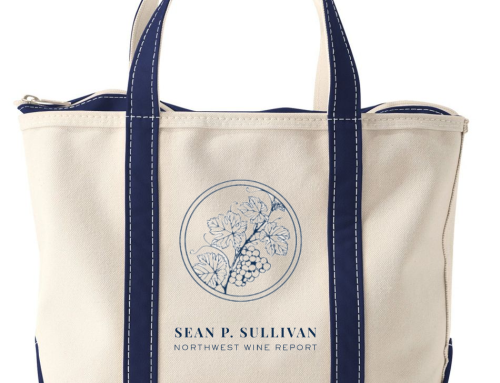
Northstar Winery was founded in 1994 by Stimson Lane, the parent company of Chateau Ste Michelle, with the goal of producing high end Merlot (Stimson Lane has subsequently been renamed Ste Michelle Wine Estates).
“Back then, Merlot was the number one red in the U.S.,” recalls Northstar winemaker David Merfeld.
There were plenty of reason to believe that Washington could excel at making Merlot. Leonetti Cellar, Woodward Canyon, Andrew Will, Seven Hills Winery, and many others had shown great success with the variety. There was even talk of Merlot being Washington’s ‘signature variety.’
These were also still relatively early days in the Washington wine industry. While there had been plenty of successes, there was also concern about the state’s cold winters and, to some extent, whether it was warm enough to consistently grow certain red varieties. In this way, Merlot seemed a perfect fit.
“Merlot always gets ripe in Washington,” Merfeld says. “Going back to when I was first starting 20 something years ago, in those vintages Cab didn’t always get ripe. In cooler vintages, it didn’t quite make it. The quality was not as high as it is now. Merlot always got ripe.”
Back in 2000, David Merfeld was working as a brewer at Bert Grants, a brewery owned by Stimson Lane. When the company prepared to sell the brand, they asked Merfeld if he wanted to stay on board, working for Northstar.
“I went directly from the brewery,” Merfeld recalls. “It was right after Labor Day weekend, and I went to our winery at the old Saddle Mountain location.”
Merfeld started out working the night shift overseeing white wine pressing for Ste Michelle, while working at Northstar during the day.
“It was the first time I’d ever seen grapes being harvested,” he recalls.

What does Merfeld believe makes Merlot special as a variety?
“I love Merlot because to me it’s just an elegant wine with a velvety texture to it. It pairs well with so many foods. Cabernet I love, but that one kind of hits you over the head.”
Northstar makes three different offerings of Merlot. The first is its flagship Columbia Valley wine, which has been produced since 1994. This Merlot is sourced from over 20 different vineyards throughout the valley. Starting in 2000, Northstar also started making a Walla Walla Valley Merlot.
“Walla Walla is a special place [for Merlot],” Merfeld says. “We’ve probably got three different types of wines you can make, from the valley floor around Pepper Bridge and Northstar to Spring Valley down to all of the things that are going on down by Seven Hills and Anna Marie [Vineyard].” The winery also makes a Premier Merlot, intended for longer term aging.
Washington Merlot is known for its often firmer tannic structure than many of the wines found elsewhere in the world. This along with its ripe, sumptuous fruit flavors, are what delivers so much of the appeal of Washington Merlots. One of the ways that Merfeld accommodates for this additional structure is by using a substantial amount of whole berry fermentation, often between 40-60%.
“That definitely helps to soften the wines,” he says. Merfeld also prefers a slower overall fermentation.
“I like it better when I stretch it out for the tannins, and I also think you get better aromatics. You lock them in a little better.”
For March, my 2020 Washington Merlot Challenge wine was the Northstar 2010 Columbia Valley Merlot. 2010 was a cool vintage, the coolest the state had seen since 1999. The wine was in a beautiful spot, still seeming remarkably youthful, with notes of mint, raspberry, and chocolate. It had the smooth, textured palate that great Washington Merlot can offer along with the vibrant acidity of the vintage.
“I love the cooler vintages,” Merfeld says. “We’ve adjusted and adapted to these [recent] warmer vintages, but the cool ones always stand out. We always get phenolic ripeness and color. It’s about locking that acid in. That vintage was pretty special.”
In the last decade, Cabernet Sauvignon has risen to supremacy in Washington, now making up 44% of the state’s annual red grape production. Merlot has taken a back seat. Merfeld is sanguine about the state’s turn toward Cabernet.
“I don’t think there’s any stopping Cabernet right now,” he says, noting that Washington can do the variety particularly well.
“It’s really high quality especially for the price out of Washington State. People dig it and want it. That’s not going away, but hopefully we maintain our Merlot and have it grow.”
As I have written before, Washington becoming the land of Cabernet does not make the state’s Merlots any less compelling than they were 20 years ago. These remain world class wines. If you’re looking for a primer on what the state can do with the variety, Northstar is an excellent place to start.
“We’ve done tastings with Merlot from all over the world, and Washington stands out,” Merfeld says. “I’m not just saying that because we’re here. I’ve had some really good Merlot from Italy and from France. But they are usually pretty expensive.”
In contrast, Washington can offer exceptional quality Merlot at reasonable prices, creating wines that rank among the best in the world.
“I don’t think anybody does it better than Washington State for Merlot,” Merfeld says. “This is the spot. That’s why I’m at Northstar.”







Leave A Comment